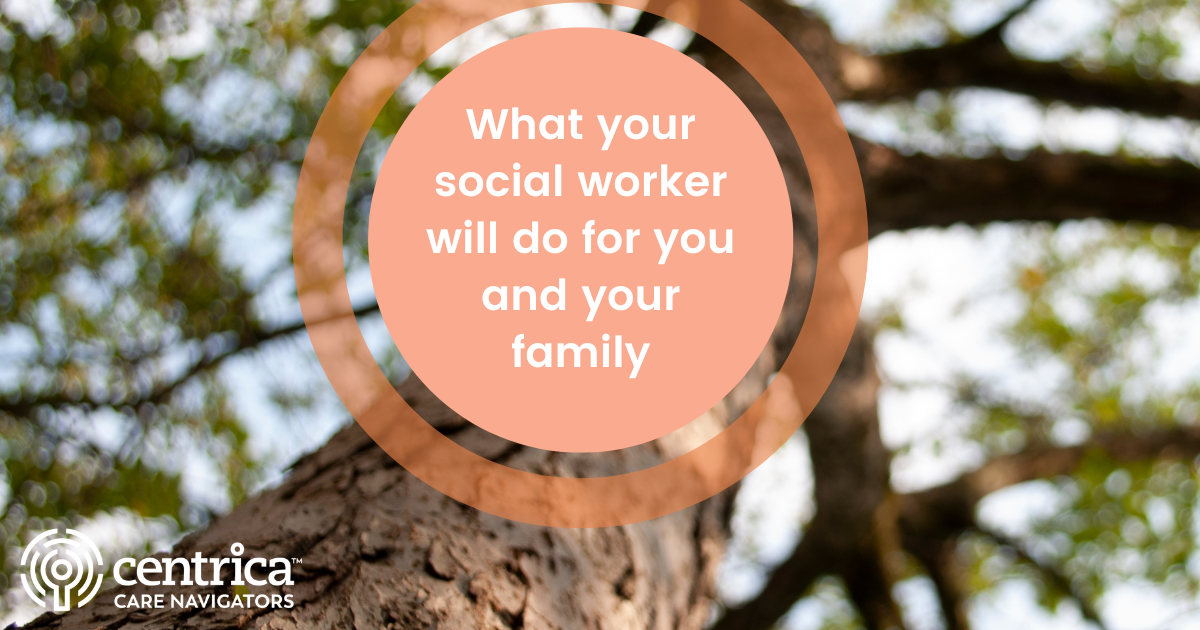Many people say that when it comes to their job, there is no “normal.” But when it comes to the role of a social worker, where every day is spent getting to know people and helping improve their lives, it might be even more true.
“A lot of my time is validating and acknowledging them, just holding their hand if that’s what they need,” says Rachel Giddings, a Centrica Care Navigators social worker. “The biggest thing you can do is listen.”
A social worker is part of the IDG (interdepartmental group) that meets with each and every patient who receives service with Centrica Care Navigators. While doctors and nurses manage medical care, and chaplains address spiritual issues, social workers handle many other things. This can be financial assistance, like filling out forms, or putting patients in contact with resources such as Meals on Wheels, if the patient isn’t getting nutritious food regularly. Social workers can also help with funeral planning.
Perhaps most importantly, though, their role is about making connections: talking to patients and their caregivers to find out what they need to feel as comfortable as they can.
“Families don’t know what to expect (and) patients feel overwhelmed and scared,” says social worker Jaime Laisure. “They want somebody to listen.”
Social workers at work
Social workers make about 15 to 20 visits in a week, usually to a patient’s home, where they often simply sit and talk. The initial visit, when they’re first meeting a patient and caregivers, lasts about an hour and a half to two hours.
Laisure says she uses that time to determine where patients are legally, financially, and emotionally. She tries to build connections to the patient and caregivers, so they feel comfortable asking her to help make the end of life more comfortable as it draws to a close.
Later meetings are often shorter, and sometimes a phone call to check in is all that’s needed. Other patients only want to visit with a social worker once a month.
Giddings says one recent meeting went to more than three hours, though. It was an opportunity to talk with a patient’s caregiver about finding a funeral home and updating the advance directives form for the patient, a document which states what the patient wants for their end-of-life care if they’re unable to make decisions on their own. Putting those thoughts down on paper demands a lot of careful consideration.
Questions about care
While every situation is unique, Giddings says there are some questions she’s asked by many patients.
“People are worried they can’t stay at home when they’re in hospice; they want to know who will take care of them; they ask, what will happen to their family after they die,” she says.
Social worker Christy Metzger says a lot of her role is just providing information to patients and families. People know they need some kind of help, but they’re not sure where to find it, or how to make a request once they do find a resource. That’s where the social workers step in.
Need a ride to an appointment? Social workers can put patients in touch with a transportation service. Need legal aid? There’s a phone number for advocacy services. In-home care? Many places in southwest Michigan offer that kind of service.
Building relationships
In order to learn what’s needed by a patient or family, social workers have to develop relationships and encourage people to talk about their situation.
“Family members start sharing stories; it’s my way to get to know them,” Laisure says. “Sometimes people are crying, but I’ve seen people laugh. Their life kind of gets lost (dealing with hospice care) — we bring it back in.”
She says she looks for any avenue she can to uncover what a patient or family needs. She’s talked about movies and politics, and listened to stories about World War II, all in the name of getting a conversation started. A discussion about what’s on TV may turn in time to a talk about a patient’s worries for the future.
“We work on coping strategies,” Laisure says. “We talk about what’s bothering them and identify unresolved issues.”
Social workers help caregivers, who are usually family or friends of the patient. They explain what the end of life looks like physically. They also help with caregiver burnout, giving people ideas on healthy, safe ways to cope with the stress of supporting a dying person. They look for signals that a person is anxious or depressed, and have suggestions on ways to manage those feelings.
In a lot of situations, the role of caregiver falls mainly on one person, even when there are other family members nearby who visit or occasionally lend a helping hand. Metzger says that’s when a social worker is key.
“We ask, how can we help lighten some of that load?” she says.
Opportunities for care
Social workers say working with hospice patients and their caregivers gives them opportunities they don’t have if they focus on other groups, like children or people in rehabilitation for drug use. Metzger says families have told her it’s “eye-opening” that their loved one can receive end-of-life care in their own home, and that they don’t have to go to the hospital. They’re also relieved that there’s someone just a quick message away who can help with the complicated paperwork and the many questions they have.
“I can leave (a meeting) knowing they don’t have to make that phone call since I talked to that person for them,” Giddings says.




